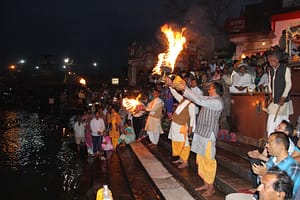The history of Haridwar can be traced back to the ancient times. It has been mentioned in the Hindu epic Mahabharata. From 322–185 BCE, it was under the Mauryan empire and under Kushan empire from 1st to 3rd century AD. During the reign of King Harshavardhan, a Chinese traveller named Hiuen Tsang visited India in 629 AD, and wrote the first modern era account of Haridwar. On 13 January 1399, Central Asian ruler Timur Lang conquered the city. Guru Nanak, the first Sikh Guru, also visited Haridwar. It is believed that Mughal emperor Akbar, drank water from the Ganges. Raja Man Singh of Amber is said to have established the present day city. Under the British, Haridwar Union Municipality was created in 1868. After independence, rapid development of Haridwar occurred in the 1960s, with the setting up of BHEL in 1962. The University of Roorkee (now IIT Roorkee) in Haridwar district, is one of the oldest and most prestigious engineering institutes in the country.
Haridwar is considered as one of the holiest cities for Hindus. It serves an entry point to the Char Dham, the four key pilgrimage centres in Uttarakhand, namely Badrinath, Kedarnath, Yamunotri and Gangotri. Its religious heritage is reflected in the beautiful architecture of its temples. The city is famous for its religious festivals and fairs, which attract millions of pilgrims every year. Kumbh Mela is the most awaited fair, which occurs every 12 years. Ardh Mela, Kanwar Mela, Somwati Amavasya, Katrik Purnima and Ganga Dusshera are other fairs and festivals. The city is also a centre of classical music and dance forms, most of which are performed to praise the Gods. Yoga is an integral part of the culture of Haridwar. There are many yoga ashrams in the city, who aim to impart spiritual education and physical fitness to the people.
Given the spiritual importance of Haridwar, the people of Haridwar are very religiously inclined. They are proud of their culture and have significantly contributed to the religious heritage of the city. The city is home to 310,562. Hindus form a majority of the population at 92%, followed by Muslims at 5%, Christians at 0.7%, Jains at 1.1%, Sikhs at 1% and Buddhists at 0.2%. The people lead a very simple lifestyle and adhere to their traditions. Traditional Indian attire is popular in Haridwar, though western dresses are also slowly gaining popularity.

